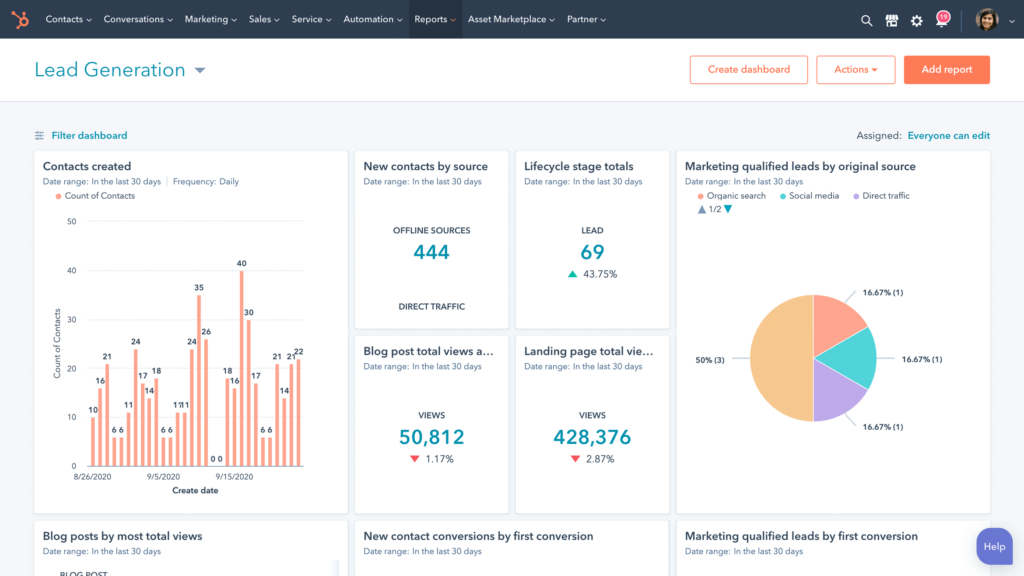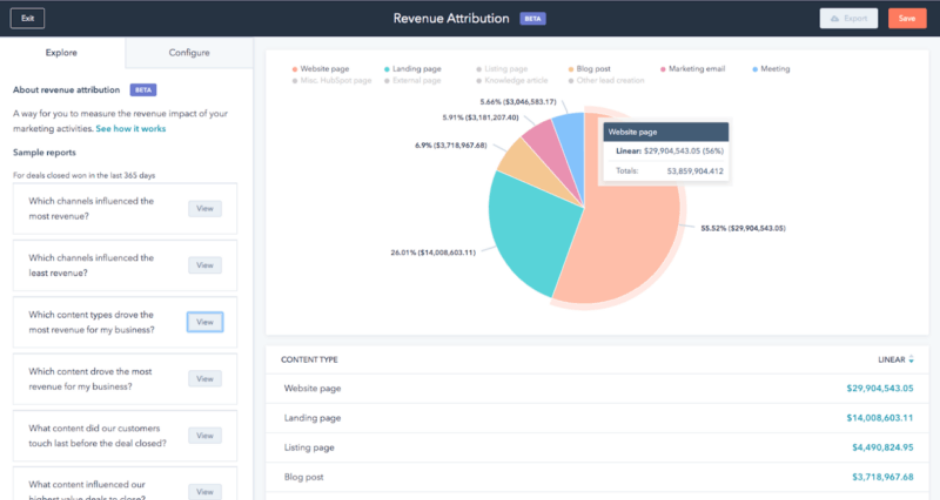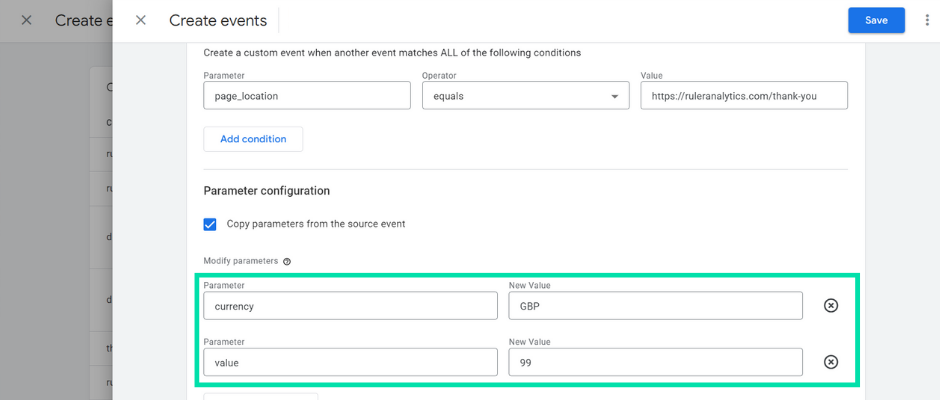“How is it impacting our bottom line? What’s our ROI?”
These are questions every owner and manager ask on a regular basis – especially when it comes to marketing.
Yet many marketing teams can’t give confident answers to these questions.
Why?
They’re not tracking appropriately, failing to attribute accurately, or they simply can’t track what they want.
Digital marketing solves for all three issues in a way some traditional marketing tactics can’t.
In this blog, we’ll explore how digital marketing helps find these answers, maximizes your marketing budget, and helps you grow – in ways traditional marketing tactics simply can’t.
Measuring Marketing Attribution: Traditional vs Digital Marketing Tactics
Understanding the success of your marketing efforts comes down to one key concept: attribution. It’s the process of identifying which marketing tactics led your customer to make a purchase.
Traditional marketing includes methods like TV or newspaper ads, and digital marketing involves tactics used on the internet, such as social media or email campaigns. For the most part, digital marketing tactics offer far more visibility into what’s working and what’s not. Let’s look at how the two compare.

Traditional Marketing Attribution
Traditional marketing encompasses offline methods like TV ads, radio spots, print ads, and billboards. These methods can reach broad audiences, but they face hurdles in marketing attribution.
Limited Data Availability
The first stumbling block is limited data. Gauging how many people see a billboard or watch a TV commercial is challenging. The data that is available typically provides estimations, lacking the granularity of digital marketing data.
Inability to Track Offline Interactions
The second hurdle is tracking offline interactions. For instance, if a customer sees a billboard and later makes a purchase, attributing this purchase to the billboard is difficult. This lack of a direct link makes accurate ROI calculation tricky.
In comparison, digital marketing can provide real-time data and detailed tracking, painting a clearer picture of customer behavior and ROI. However, it’s important to use a balanced mix of both digital and traditional marketing methods for an effective strategy.
Digital Marketing Attribution
Digital marketing has revolutionized the way businesses approach marketing attribution, offering key benefits that significantly outshine those of traditional methods.
Access to Real-Time Data
The first major benefit is access to real-time data. Unlike traditional marketing, which often relies on estimates and delayed reporting, digital marketing provides immediate data for accurate marketing reporting. This allows marketers to monitor the performance of their campaigns in real time, make quick decisions, and optimize their strategies on the fly. For example, if a particular social media ad isn’t performing as expected, businesses can swiftly adjust their messaging or target audience based on live feedback.
Multi-Channel Tracking
Another distinct advantage is multi-channel tracking capabilities. Digital marketing can accurately track customer interactions across different platforms and channels. This means you can see if a customer first saw your Google Display Ad, then visited your website and finally submitted a form on a blog post. This kind of multi-touch attribution paints a comprehensive picture of the customer journey, enabling you to understand which marketing touchpoints are most effective and deserve more of your budget.

Hubspot
The granular data provided by digital marketing platforms allows for a more precise and dynamic understanding of marketing ROI. With this level of detail, businesses can make informed decisions, maximize their budget, and ultimately drive higher returns.
How to Measure Digital Marketing ROI?
Return on Investment (ROI) is a critical metric that shows the efficiency and profitability of an investment. In the context of digital marketing, ROI helps businesses understand the value generated from their online marketing efforts. You can measure overall marketing ROI, break it down by campaign, break it down by channel/source, and more.
To get a big picture view of digital marketing ROI, you can run a simple calculation:
(Sales Growth – Marketing Cost) / Marketing Cost = ROI
This is helpful, but it doesn’t necessarily let you know what’s working and what’s not. In fact, you can’t even be sure that your sales growth came from marketing efforts or not.
This is the beauty of digital marketing – you can break your ROI down by specific channels – and be confident your sales growth came directly from them. So when it comes to digital marketing, we’d recommend tracking ROI by channel/source and by specific campaigns. Let’s look at a few examples:
Tracking ROI from SEO Efforts:
(Revenue Attributable to SEO – SEO Marketing Costs) / Marketing Cost = SEO ROI
Tracking ROI from digital advertising:
(Revenue Attributable to SEO – Ad Spend – Any Ad Management Costs) / Marketing Cost = Digital Advertising ROI
We’re making progress toward true ROI, but how can you determine revenue attributable to a specific channel? Here are some strategies and tactics to help.
Implement Tracking Tools and Track the Customer Journey
Start by setting up the right tracking tools. Google Analytics is a powerful tool that can track a wide range of metrics such as website traffic, user behavior, and conversion rates. You can also set up goals in Google Analytics to track specific actions users take on your website, like filling out a form or making a purchase. You can then connect Analytics with your CRM to track conversions to deals/proposals, and eventually to new revenue.
You can also use an all-in-one marketing automation tool like HubSpot which will take care of a lot of the attribution for you, and save you from tricky integrations between Analytics and your CRM. HubSpot can help you track the entire journey, from first touch through sale. And even better – HubSpot will help you track revenue per source/channel and per specific campaign.

If you don’t use a marketing automation tool or integrate Analytics with your CRM, you can still attribute and track ROI, but it’s a little trickier. One of the easiest ways is to use Analytics, set up proper conversions, and assign those event values.
For example, let’s say you close 50% of your qualified leads for an average deal of $10,000. 10% of those who fill out a form on your site are qualified. So you might say each form fill on your site is worth $500 on average. You would assign website form fill conversions a $500 value. This won’t give you an exact revenue amount generated by form fills, but it will be a good estimate.

From there, you can use Analytics to break down values from each source (organic, paid search, social, email, etc…) if you’re using UTMs and tracking properly (see below).
Consider Attribution Models
An attribution model is a method used to determine how conversion value is assigned to different marketing channels. There are several models to choose from, each with its strengths and weaknesses. For instance, the first-click model attributes all the credit to the first touchpoint, while the linear model equally distributes the credit among all touchpoints.

There’s no right or wrong approach to attribution – it depends largely on your product/service and the buying cycle. Many in the digital marketing world prefer first touch or linear attribution.
Use UTM Parameters
If you’re going to take a more manual approach to attribution through Google Analytics, UTM parameters a must. These are tags added to a URL that track the success of a specific marketing campaign. They provide insights into where your website traffic is coming from, allowing you to track customers from email click through to sales and revenue. If you want to attribute revenue from sources like email, newsletters, or offline strategies, UTM parameters are a must.

How Digital Marketing Impacts the Bottom Line
Every business owner’s ultimate goal is to improve their bottom line, and digital marketing can play a crucial role in achieving this. It does so by driving customer acquisition, increasing sales, and providing valuable insights that allow for strategic decision-making.
One of the most powerful features of digital marketing is its ability to precisely measure the impact of each campaign. While it’s ideal for a campaign to yield a significant ROI, even those that don’t provide substantial returns offer valuable information. They shed light on what’s working and what isn’t, enabling businesses to optimize their strategies.
For instance, a paid search campaign may not result in a huge number of immediate sales, but it may drive substantial traffic to your website. This could boost brand awareness and potentially lead to increased sales down the line. Moreover, analysis of the campaign could reveal useful demographic data about the visitors, helping to refine target audiences for future marketing efforts.
Unlike traditional marketing methods, which often struggle to provide detailed or real-time data, digital marketing gives you a clear picture of campaign performance. You can track engagement, conversion rates, bounce rates, and many other metrics that directly influence your bottom line. This immediate feedback allows you to adjust your strategy as needed, helping to prevent wasteful spending and maximize your marketing budget.
In a nutshell, digital marketing’s strength lies in its transparency and adaptability. Even when campaigns don’t yield immediate or high ROI, they still provide essential data and insights. These insights facilitate informed decision-making, optimization of marketing strategies, and, ultimately, a healthier bottom line. If you need help tracking your digital marketing ROI, or you want to make the switch from traditional to digital so that you can see the correlation more clearly, contact our digital marketing team. We’d love to help.






